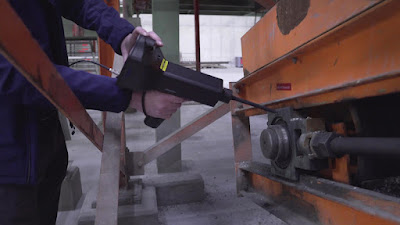Monitoring the low speed bearings
Bearings are an essential component of any industrial machinery or equipment that involves the movement of parts. Over time, bearings wear out, which can cause equipment failure, costly downtime, and loss of production. In particular, low-speed bearings require continuous monitoring and maintenance to ensure their optimal performance. The reason is that low-speed bearings operate in conditions with high torque and low rotational speed, which can lead to false brinelling or corrosion if they are not properly lubricated or protected. Thus, monitoring the low-speed bearings requires attention to detail and a robust maintenance program. In this blog post, we will discuss the importance of monitoring low-speed bearings, explain the various monitoring methods and tools available, and share some best practices for monitoring them. We will provide insights into why continuous monitoring is critical, particularly in industrial applications, and the role it plays in reducing equipment failure and increasing operational efficiency. By the end of this blog post, you'll have a better understanding of how to implement a comprehensive low-speed bearing
1. Importance of monitoring low-speed bearings.
Monitoring the low-speed bearings in industrial machinery is crucial for ensuring optimal performance and preventing catastrophic failure. Low-speed bearings operate under highly demanding conditions, and early detection of issues can significantly reduce the risk of equipment downtime and costly repairs. Regular monitoring of low-speed bearings can identify fault conditions such as misalignment, improper lubrication, and excessive wear, which can lead to sudden equipment failure if not addressed promptly. With proper monitoring procedures in place, plant operators can identify and diagnose potential problems before they escalate into major issues, allowing corrective actions to be taken in a timely and cost-effective manner. In this document, we discuss the importance of monitoring low-speed bearings and provide useful insights into best practices and techniques that can be employed to ensure optimal performance and safety of industrial machinery.
2. Identify potential issues early by monitoring vibration and temperature.
Monitoring the low-speed bearings is critical for ensuring the smooth operation and longevity of machines. One way to identify potential issues early is by monitoring vibration and temperature. Vibration analysis can detect changes in the vibration patterns of bearings, which can be indicative of potential faults such as wear or misalignment. Similarly, monitoring temperature can identify anomalies that could indicate a problem, such as overheating due to increased friction. By monitoring these factors regularly, potential issues can be identified and addressed before they become major problems that could cause costly downtime or even catastrophic failure. This proactive approach to maintenance can also help to extend the lifespan of bearings and machines, ultimately saving time and money in the long run.
3. The use of specialized equipment, such as stethoscopes, to monitor bearings.
The use of specialized equipment, such as stethoscopes, is essential in monitoring the low-speed bearings used in industrial settings. Stethoscopes provide an audible representation of the bearing's sound and vibration patterns which allows for early detection of potential faults. In turn, this early detection can prevent costly downtime and increase the overall lifespan of the bearings. It is crucial to have trained professionals routinely monitor the bearings with this specialized equipment to ensure their optimal performance. Accurately identifying and addressing potential faults in the initial stages of wear and tear can prevent more severe issues from developing, saving both time and money in the long run. Therefore, use of specialized equipment such as stethoscopes is a critical component of maintaining the health of low-speed bearings in industrial settings.
4. Regular inspection and maintenance to ensure the longevity of low-speed bearings.
Monitoring the Low-Speed Bearings is essential to ensure the smooth operation of machinery and prevent any unwanted downtime. One of the key factors in maintaining low-speed bearings is regular inspection and maintenance. Low-speed bearings, employed in various applications including conveyor systems, generators, and turbines, are designed to operate at slower speeds than high-speed bearings. Therefore, they are susceptible to wear, tear, and other failures that can lead to damage to the equipment.
To ensure the longevity of low-speed bearings, it is recommended to establish a maintenance schedule in accordance with the manufacturer's recommendations. This maintenance schedule should include regular inspection, cleaning, lubrication, and replacement of any worn or damaged bearings. Furthermore, regular monitoring of the operating conditions of the machinery can help identify any signals of bearing wear or damage early on, preventing further damage and ensuring the smooth operation of the equipment. With regular inspection and maintenance, low-speed bearings can provide a long operating life, minimizing the risk of equipment failure and costly downtime.
5. The benefits of utilizing experienced professionals to monitor and maintain low-speed bearings.
Monitoring and maintaining low-speed bearings is crucial to ensuring the smooth and efficient operation of machinery. They are required to withstand heavy loads and high temperatures, making them a vital component of industrial equipment. The benefits of utilizing experienced professionals to monitor and maintain low-speed bearings cannot be overstated. These experts have the knowledge and skill required to recognize potential issues and address them before they turn into major problems. With regular monitoring, the professionals can detect early signs of wear and tear, allowing for timely maintenance and repair. They can also identify the appropriate lubricant type and ensure its proper application, which is essential for prolonging the life of the bearings. Overall, utilizing experienced professionals to monitor and maintain low-speed bearings can save significant costs by preventing downtime, reducing maintenance and repair expenses, and increasing the life of the equipment.
In conclusion, monitoring low-speed bearings is critical for ensuring the efficient and reliable operation of various industrial equipment. With advancements in technology, such as vibration monitoring and oil analysis, it has become easier to detect issues before they result in costly downtime. By implementing a proactive maintenance strategy that includes regular monitoring and testing, industry professionals can extend the lifespan of their equipment and minimize the likelihood of unexpected failures. In short, monitoring low-speed bearings is a crucial aspect of industrial maintenance that should not be overlooked.




Megjegyzések
Megjegyzés küldése